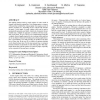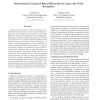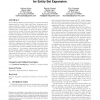304 search results - page 47 / 61 » Learning Object Categories from Google's Image Search |
WSDM
2009
ACM
14 years 2 months ago
2009
ACM
The ranking function used by search engines to order results is learned from labeled training data. Each training point is a (query, URL) pair that is labeled by a human judge who...
APGV
2004
ACM
14 years 1 months ago
2004
ACM
Many common materials, including fruit, wax and human skin, are somewhat translucent. What makes an object look translucent or opaque? Here we use a recently developed computer gr...
ICCV
2011
IEEE
12 years 7 months ago
2011
IEEE
In the real visual world, the number of categories a classifier needs to discriminate is on the order of hundreds or thousands. For example, the SUN dataset [24] contains 899 sce...
CIKM
2009
Springer
14 years 2 months ago
2009
Springer
Sets of named entities are used heavily at commercial search engines such as Google, Yahoo and Bing. Acquiring sets of entities typically consists of combining semi-supervised exp...
ECCV
2010
Springer
13 years 9 months ago
2010
Springer
Many visual search and matching systems represent images using sparse sets of "visual words": descriptors that have been quantized by assignment to the best-matching symb...



